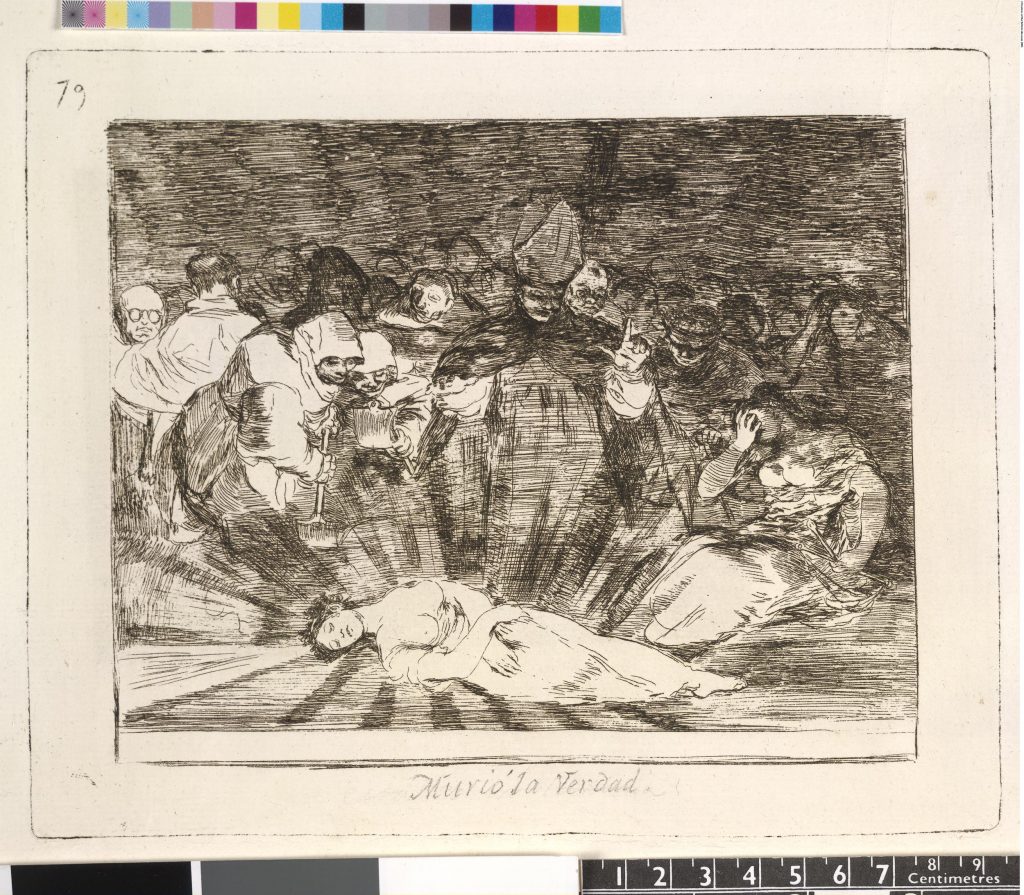Abstract
Goya completed Los Desastres de la Guerra during the Peninsular War (1808 to 1814), soon after Napoleon’s brutal occupation of Spain, which sparked a popular uprising among the Spaniards and violent repression by the French. The full title for the series was Fatales consequencias de la sangrienta guerra con Buonaparte. Y otros caprichos enfáticos en 85 estampas. Inventadas, dibuxadas, y grabadas por el pintor original D. Francisco de Goya y Lucientes. (translated: Fatal consequences of the bloody war with Buonaparte, and other emphatic inventions in 85 prints. Invented, drawn, and engraved by the original painter Francisco de Goya y Lucientes). The artist may have initially held Bonapartist sympathies, admiring the liberal vision for a more egalitarian world. Goya became thoroughly disillusioned, however, as he observed the depredations, domination, and systematized violence inflicted by the invading French as Napoleon installed his own brother on the Spanish throne.
There are very few precedents for this wrenching level of graphic depiction of war, notably the 18 etchings circa 1633 of Les Misères et les Malheurs de la Guerre (The Miseries and Misfortunes of War) of Jacques Callot, a set that was widely circulated. Goya echoes the format of Callot’s print cycle in placing text beneath graphic depictions of atrocities and executions, but Callot’s images seem remote, historic narrative, whereas Goya’s grisly scenes ard brought to the forefront, producing immediate, visceral reactions. They are impossible to look at without feeling abhorrence and revulsion, their impact undiminished even now in an era where violent, horrific, uncensored images can be transmitted virtually instantly around the world (and we see the murder of George Floyd in nearly real time).
References
https://www.dailyartmagazine.com/goya-disasters-of-war/
https://fundaciongoyaenaragon.es/obra/tristes-presentimientos-de-lo- que-ha-de-acontecer/720
https://www.goyaenelprado.es/obras/lista/?tx_gbgonline_ pi1%5Bgocollectionids%5D=27
http://www.realacademiabellasartessanfernando.com/es/goya/goya- en-la-calcografia-nacional/desastres-de-la-guerra
López-Alós, Javier, Alternative Forms of Historical Writing: Concepts and Facts in Goya’s Disasters of War, https://www.bloomsburycollections. com/book/theories-of-history-history-read-across-the-humanities/ ch9-alternative-forms-of-historical-writing-concepts-and-facts-in-goya-s- disasters-of-war?from=search
Heckes, Frank I., Reason and Folly, The Prints of Francisco Goya, National Gallery of Victoria, Australia, 1998
McNutt, Beverly, Goya and the International Art Movements of his Time, Morehead State University, 1991
Sayre, Eleanor, et. al., Changing Image, Boston: Museum of Fine Arts, 1974
Stepanek, Stephanie Loeb, Curator Emerita of Prints and Drawings, Museum of Fine Arts, Boston, email conversations to Brian D. Cohen, October 2020
Tomlinson, Janis, Graphic Evolutions: The Print Series of Francisco Goya, New York: Columbia University Press, 1989
Tomlinson, Janis, Director of University Museums at the University of Delaware, email conversations with Brian D. Cohen, February 2021
Peter Schjeldahl, Goya and the Art of Survival, The New Yorker, September 14, 2020
Vega, Jesusa, The Dating and Interpretation of Goya’s “Disasters of War,” Print Quarterly, March 1994
Wolf, Reva, Onlooker, Witness, and Judge, from the 1990 exhibit Fatal Consequences at Dartmouth College, preface by James Cuno, introduction by Hilliard Goldfarb, Curator of European Art, essays by Hilliard Goldfarb and Reva Wolf, Boston College, 1990

This work is licensed under a Creative Commons Attribution 4.0 International License.
Copyright (c) 2021 Brian D. Cohen
